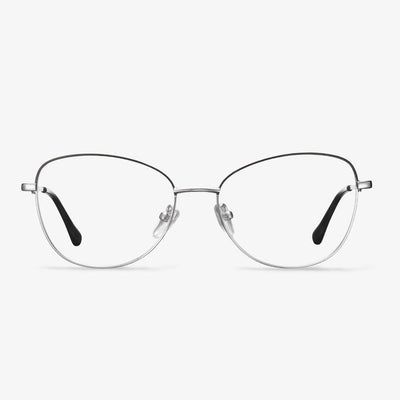Different Type of Lenses: How to Choose
In this section, we will list some of the lenses for glasses.
Plastic lenses: In 1947, the Armorlite Lens Company in California introduced the first lightweight plastic lenses. The lenses were made of a plastic polymer called CR-39, because it was the 39th formulation of a thermal-cured plastic developed by PPG Industries in the early 1940s. Plastic lenses are light and low cost.
Polycarbonate lenses: polycarbonate lenses were first introduced in the 1970s and they have become increasingly popular anad remained for a long time. Polycarbonate glasses are slighter and significantly more impact-resistant than CR-39 plastic, making them a preferred material for children’s eyewear, safety glasses, and sports eyewear.
How are we nearsighted?
The light from external objects to the eye needs to be refracted by the lens before it can be imaged on the retina. The refractive power of the lens depends on the contraction and relaxation of the ciliary muscle. When we look at close objects, the ciliary muscles contract and the lens becomes thicker. When we look at distant objects, the ciliary muscles relax and the lens becomes thinner. Adjust the focal length of near and far objects so that they will show a clear image on the retina. If you use your eyes too often and the longer the ciliary muscles work continuously, the ciliary muscles will spasm because of too much tension. At this time, the lens cannot be adjusted and thinned. After the light from a distant object is refracted by the lens, the imaging position will fall in front of the retina instead of on the retina. Only a blurred image can be seen, which becomes myopia.
There is another situation. For some people, due to genetic factors, in the process of growth and development, the front and rear wheelbase of the eyeball will gradually become longer. In this way, although the adjustment function of the ciliary muscle and the lens is normal, the image formed will also fall in front of the retina due to the longer the axis distance of the eyeball, which can also cause myopia.
The two causes of myopia are different. Myopia caused by ciliary muscle spasm is called 'pseudo-myopia'. As long as the ciliary muscles are relaxed, myopia can be reversed. Myopia caused by the extension of the wheelbase of the front and back of the eyeball is called 'true myopia', which cannot be reversed and can only be corrected by myopia glasses.
How to choose progressive lenses
The progressive lens can effectively control the deepening of myopia, but there is no reliable empirical evidence. At present, the height of the lens frame is only about 30mm. The distance from the design of the transition interval is not enough, and the comfort of the eye is difficult to adjust the short distance. From the quality and technology, the foreign brand design process is stable and mature, but the price is too high, there are still a lot of people who are not easy to adapt. The parameters of progressive lenses need to be determined by strict optometry.
Do Colorblind Glasses Work?
To understand colorblind glasses well, you need to know how color blindness happens first. The human eye contains three photopigments that are sensitive to color. These photopigments are located inside receptors in the retina called cones, which can tell your eyes how much blue, red or green is in an object. Then they give your brain information about what color objects are.
If there is not enough photopigment in your eyes, you maybe can’t see that color. Most cases of poor color vision involve red-green color deficiency. That is to say, you have the difficulty in recognizing the red and green colors.
So, how do colorblind glasses work? Colorblind glasses like Enchroma were originally manufactured as sunglasses with lens coated in a special material that exaggerated the wavelengths of light. So, it has the effect of making colors look saturated and rich.
Though colorblind glasses do not cure color blindness or produce 100% normal color vision, they allow colorblind people to perceive colors they have never seen before and experience closer-to-normal color vision while wearing special glasses for color blindness.
What Are Progressive Lenses?
Your eyes change with your age. When your reach your 40s, you may find that it is difficult for you to focus between a book, a website on a computer screen and the conference room whiteboard. Progressive lenses are growing in popularity among people who need help seeing near, far and in-between.
Progressive lenses have grown in popularity and are one of the most common solutions to treat vision loss that occurs with age or presbyopia. Progressive lenses have a seamless increase in magnification from the top to the bottom of the lens, helping you see clearly at all distances with just one pair of glasses. The top portion of the lens enables you to see the far-away objects, the middle portion of the lens enables you to focus on the intermediate objects and the bottom to see objects close-up. The prescription changes little by little across the lens surface providing a gentle transition.
After knowing what the progressive lenses are, do you know what are the pros and cons of progressive lenses? If not, keep on your reading and we will show you some information.
Advantages of Metal Frames
The metal frame of eyeglasses conforms to the use performance of the frame. They need the material to have high fracture strength, enough plasticity, toughness, and good elasticity. And after the disappearance of the external force, they can restore to the original shape. This is the regular demand for the high elasticity of the metal frame. They must be able to withstand the atmosphere and human sweat daily corrosion. Usually, the corrosion resistance of pure titanium eyewear will be better than other eyewear. Some glasses will have a variety of wonderful grinding designs, and the material must have high plasticity.
Disadvantages of titanium glasses
Titanium and titanium glasses cost a lot to produce, requirements in buckling, stamping, cutting, and welding are very high, not easy to welding and electroplating.So the price is more expensive, only for high-end glasses frames.











































